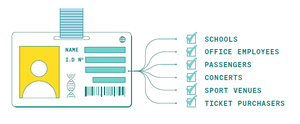Difference between revisions of "1-3-30 Plan"
(a '''corps''' of 10.000 should be recruited) |
(expanded entry) |
||
| (2 intermediate revisions by 2 users not shown) | |||
| Line 12: | Line 12: | ||
|locations=New York, USA | |locations=New York, USA | ||
|URL=https://swprs.files.wordpress.com/2020/04/rockefeller-foundation-scenarios-2010.pdf | |URL=https://swprs.files.wordpress.com/2020/04/rockefeller-foundation-scenarios-2010.pdf | ||
| − | |constitutes= | + | |constitutes=mass surveillance |
|participants= | |participants= | ||
}} | }} | ||
| Line 19: | Line 19: | ||
</ref> | </ref> | ||
| − | To this end a '''corps''' of | + | To this end a '''corps''' of 100 - 300 thousand should be recruited, equipped with digital tracking, realtime database access of patient medical records and test facilities. |
| + | |||
| + | On March 9,2020, the U.S. [[Department of Health and Human Services]] (HHS) released two final rules that would prohibit information blocking in health care and advance more seamless exchange of health care data. | ||
| + | |||
| + | The plan states plans for this testing to be linked to a de facto forced health certificate linked to an ID, since the testing would "allow the infection status of most Americans to be accessed and validated in a few required settings and many voluntary ones" and (...)"infection status must be known for people to participate in many societal functions" (...) | ||
| + | |||
| + | "Whenever possible, incentives should be used to [[nudge unit|nudge]] the voluntary use of these apps rather than require them". But the examples given shows that it would in effect be mandatory, since one can't travel or get access to services by refusing: | ||
| + | |||
| + | Those screened must be given a unique patient identification number that would link to information about a patient’s viral, antibody and eventually vaccine status under a system that could easily handshake with other systems to speed the return of normal societal functions. Schools could link this to attendance lists, large office buildings to employee ID cards, [[TSA]] to passenger lists and concert and sports venues to ticket purchasers. | ||
| + | |||
| + | [[file:1330.png|300px]] | ||
| + | |||
==Original paper== | ==Original paper== | ||
| Line 27: | Line 38: | ||
==References== | ==References== | ||
{{reflist}} | {{reflist}} | ||
| − | |||
Latest revision as of 04:26, 24 May 2020
| Date | April 2020 - Present |
|---|---|
| Location | New York, USA |
| Perpetrators | Rockefeller Foundation |
| Interests | pandemics |
| Description | A Rockefeller Foundation sponsored large scale surveillance proposal and simulation. Held April 2020 |
The 1-3-30 Plan calls for testing and tracing of all Americans – initially 1 million per week, then 3 million per week and finally 30 million per week until every single American is assimilated into a vaccination database. [1]
To this end a corps of 100 - 300 thousand should be recruited, equipped with digital tracking, realtime database access of patient medical records and test facilities.
On March 9,2020, the U.S. Department of Health and Human Services (HHS) released two final rules that would prohibit information blocking in health care and advance more seamless exchange of health care data.
The plan states plans for this testing to be linked to a de facto forced health certificate linked to an ID, since the testing would "allow the infection status of most Americans to be accessed and validated in a few required settings and many voluntary ones" and (...)"infection status must be known for people to participate in many societal functions" (...)
"Whenever possible, incentives should be used to nudge the voluntary use of these apps rather than require them". But the examples given shows that it would in effect be mandatory, since one can't travel or get access to services by refusing:
Those screened must be given a unique patient identification number that would link to information about a patient’s viral, antibody and eventually vaccine status under a system that could easily handshake with other systems to speed the return of normal societal functions. Schools could link this to attendance lists, large office buildings to employee ID cards, TSA to passenger lists and concert and sports venues to ticket purchasers.
Original paper
